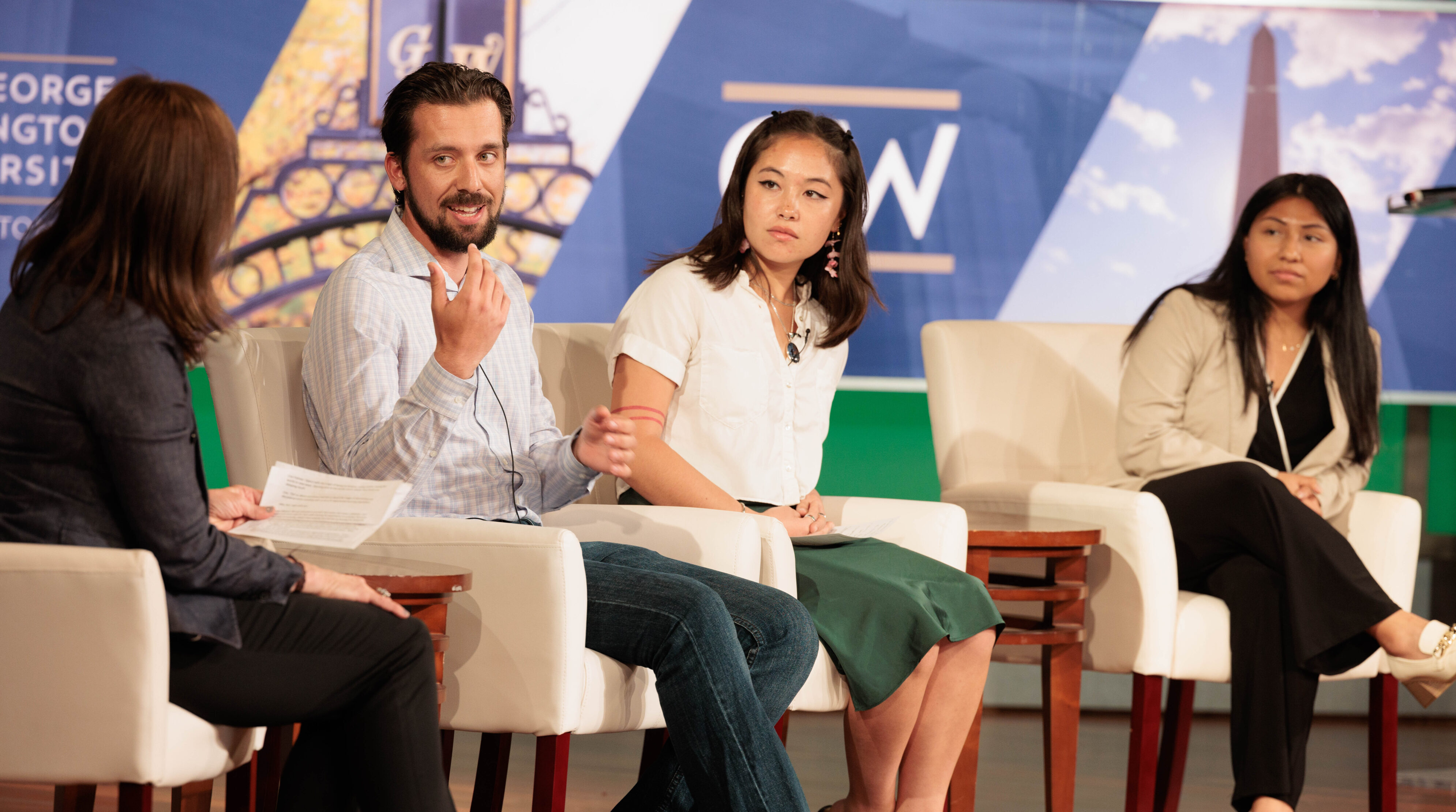 U.S. and internationally, wouldn't deny it.
These organizations believe we have a moral responsibility to protect the planet and the people who depend on it to survive. The spiritual logic, for some traditions, goes like this: God made the planet and people. God called them both “good.” Therefore, actions that help the planet and people are good, and actions that harm them are bad.
One organization, Interfaith Power & Light (IP&L), puts this logic at the center of its mission. IP&L has been working since 1998 to help religious congregations reduce their carbon footprints. IP&L has field offices in nearly every state, which offer free energy audits, bulk discounts on energy-efficient appliances, and educational resources.
If congregations can improve their energy efficiency, not only will they “walk the talk” on climate change, they will save money on their energy bills. This way, they can spend more money doing what they do best -- inspiring hope in their community, feeding the hungry, caring for the sick, etc.
IP&L, in turn, works with an unlikely source to help its partner congregations reduce their carbon footprints: Energy Star, a partnership program of the U.S. Environmental Protection Agency and U.S. Department of Energy. Just like schools, hospitals, hotels, and other buildings, religious facilities consume energy that contributes to carbon pollution. With an estimated 370,000 houses of worship across the U.S., the impact on the climate is significant. "Energy Star Congregations" reaches out to religious organizations to help them save energy, save money, and reduce their carbon footprint.
Houses of worship can track their energy use and associated carbon pollution using Energy Star’s free tracking tool, Portfolio Manager. This allows them to set targets and confirm progress. Energy Star also offers free technical assistance. This year, Energy Star “up’d the ante” when it announced that it would recognize top energy-saving congregations with the Energy Star label.
Of course, religious communities have their own spiritual, moral, and even financial reasons to reduce their impact on people and the planet. Then again, an extra nudge doesn't hurt -- whether it comes from an interfaith NGO or the government.
Do you think these organizations, IP&L and Energy Star Congregations, meet the "easy green, easy money" criteria for this blog series? Make your case.
___________________________
Peter Fargo, MBA Candidate
The George Washington University">
U.S. and internationally, wouldn't deny it.
These organizations believe we have a moral responsibility to protect the planet and the people who depend on it to survive. The spiritual logic, for some traditions, goes like this: God made the planet and people. God called them both “good.” Therefore, actions that help the planet and people are good, and actions that harm them are bad.
One organization, Interfaith Power & Light (IP&L), puts this logic at the center of its mission. IP&L has been working since 1998 to help religious congregations reduce their carbon footprints. IP&L has field offices in nearly every state, which offer free energy audits, bulk discounts on energy-efficient appliances, and educational resources.
If congregations can improve their energy efficiency, not only will they “walk the talk” on climate change, they will save money on their energy bills. This way, they can spend more money doing what they do best -- inspiring hope in their community, feeding the hungry, caring for the sick, etc.
IP&L, in turn, works with an unlikely source to help its partner congregations reduce their carbon footprints: Energy Star, a partnership program of the U.S. Environmental Protection Agency and U.S. Department of Energy. Just like schools, hospitals, hotels, and other buildings, religious facilities consume energy that contributes to carbon pollution. With an estimated 370,000 houses of worship across the U.S., the impact on the climate is significant. "Energy Star Congregations" reaches out to religious organizations to help them save energy, save money, and reduce their carbon footprint.
Houses of worship can track their energy use and associated carbon pollution using Energy Star’s free tracking tool, Portfolio Manager. This allows them to set targets and confirm progress. Energy Star also offers free technical assistance. This year, Energy Star “up’d the ante” when it announced that it would recognize top energy-saving congregations with the Energy Star label.
Of course, religious communities have their own spiritual, moral, and even financial reasons to reduce their impact on people and the planet. Then again, an extra nudge doesn't hurt -- whether it comes from an interfaith NGO or the government.
Do you think these organizations, IP&L and Energy Star Congregations, meet the "easy green, easy money" criteria for this blog series? Make your case.
___________________________
Peter Fargo, MBA Candidate
The George Washington University">
CUT CARBON, GET INTO HEAVEN?
 U.S. and internationally, wouldn't deny it.
These organizations believe we have a moral responsibility to protect the planet and the people who depend on it to survive. The spiritual logic, for some traditions, goes like this: God made the planet and people. God called them both “good.” Therefore, actions that help the planet and people are good, and actions that harm them are bad.
One organization, Interfaith Power & Light (IP&L), puts this logic at the center of its mission. IP&L has been working since 1998 to help religious congregations reduce their carbon footprints. IP&L has field offices in nearly every state, which offer free energy audits, bulk discounts on energy-efficient appliances, and educational resources.
If congregations can improve their energy efficiency, not only will they “walk the talk” on climate change, they will save money on their energy bills. This way, they can spend more money doing what they do best -- inspiring hope in their community, feeding the hungry, caring for the sick, etc.
IP&L, in turn, works with an unlikely source to help its partner congregations reduce their carbon footprints: Energy Star, a partnership program of the U.S. Environmental Protection Agency and U.S. Department of Energy. Just like schools, hospitals, hotels, and other buildings, religious facilities consume energy that contributes to carbon pollution. With an estimated 370,000 houses of worship across the U.S., the impact on the climate is significant. "Energy Star Congregations" reaches out to religious organizations to help them save energy, save money, and reduce their carbon footprint.
Houses of worship can track their energy use and associated carbon pollution using Energy Star’s free tracking tool, Portfolio Manager. This allows them to set targets and confirm progress. Energy Star also offers free technical assistance. This year, Energy Star “up’d the ante” when it announced that it would recognize top energy-saving congregations with the Energy Star label.
Of course, religious communities have their own spiritual, moral, and even financial reasons to reduce their impact on people and the planet. Then again, an extra nudge doesn't hurt -- whether it comes from an interfaith NGO or the government.
Do you think these organizations, IP&L and Energy Star Congregations, meet the "easy green, easy money" criteria for this blog series? Make your case.
___________________________
Peter Fargo, MBA Candidate
The George Washington University">
U.S. and internationally, wouldn't deny it.
These organizations believe we have a moral responsibility to protect the planet and the people who depend on it to survive. The spiritual logic, for some traditions, goes like this: God made the planet and people. God called them both “good.” Therefore, actions that help the planet and people are good, and actions that harm them are bad.
One organization, Interfaith Power & Light (IP&L), puts this logic at the center of its mission. IP&L has been working since 1998 to help religious congregations reduce their carbon footprints. IP&L has field offices in nearly every state, which offer free energy audits, bulk discounts on energy-efficient appliances, and educational resources.
If congregations can improve their energy efficiency, not only will they “walk the talk” on climate change, they will save money on their energy bills. This way, they can spend more money doing what they do best -- inspiring hope in their community, feeding the hungry, caring for the sick, etc.
IP&L, in turn, works with an unlikely source to help its partner congregations reduce their carbon footprints: Energy Star, a partnership program of the U.S. Environmental Protection Agency and U.S. Department of Energy. Just like schools, hospitals, hotels, and other buildings, religious facilities consume energy that contributes to carbon pollution. With an estimated 370,000 houses of worship across the U.S., the impact on the climate is significant. "Energy Star Congregations" reaches out to religious organizations to help them save energy, save money, and reduce their carbon footprint.
Houses of worship can track their energy use and associated carbon pollution using Energy Star’s free tracking tool, Portfolio Manager. This allows them to set targets and confirm progress. Energy Star also offers free technical assistance. This year, Energy Star “up’d the ante” when it announced that it would recognize top energy-saving congregations with the Energy Star label.
Of course, religious communities have their own spiritual, moral, and even financial reasons to reduce their impact on people and the planet. Then again, an extra nudge doesn't hurt -- whether it comes from an interfaith NGO or the government.
Do you think these organizations, IP&L and Energy Star Congregations, meet the "easy green, easy money" criteria for this blog series? Make your case.
___________________________
Peter Fargo, MBA Candidate
The George Washington University">
Cutting your carbon footprint, in some cases, can save you money. But will it help get you into Heaven? A growing coalition of religious organizations, both in the U.S. and internationally, wouldn’t deny it.
These organizations believe we have a moral responsibility to protect the planet and the people who depend on it to survive. The spiritual logic, for some traditions, goes like this: God made the planet and people. God called them both “good.” Therefore, actions that help the planet and people are good, and actions that harm them are bad.
One organization, Interfaith Power & Light (IP&L), puts this logic at the center of its mission. IP&L has been working since 1998 to help religious congregations reduce their carbon footprints. IP&L has field offices in nearly every state, which offer free energy audits, bulk discounts on energy-efficient appliances, and educational resources.
If congregations can improve their energy efficiency, not only will they “walk the talk” on climate change, they will save money on their energy bills. This way, they can spend more money doing what they do best — inspiring hope in their community, feeding the hungry, caring for the sick, etc.
IP&L, in turn, works with an unlikely source to help its partner congregations reduce their carbon footprints: Energy Star, a partnership program of the U.S. Environmental Protection Agency and U.S. Department of Energy. Just like schools, hospitals, hotels, and other buildings, religious facilities consume energy that contributes to carbon pollution. With an estimated 370,000 houses of worship across the U.S., the impact on the climate is significant. “Energy Star Congregations” reaches out to religious organizations to help them save energy, save money, and reduce their carbon footprint.
Houses of worship can track their energy use and associated carbon pollution using Energy Star’s free tracking tool, Portfolio Manager. This allows them to set targets and confirm progress. Energy Star also offers free technical assistance. This year, Energy Star “up’d the ante” when it announced that it would recognize top energy-saving congregations with the Energy Star label.
Of course, religious communities have their own spiritual, moral, and even financial reasons to reduce their impact on people and the planet. Then again, an extra nudge doesn’t hurt — whether it comes from an interfaith NGO or the government.
Do you think these organizations, IP&L and Energy Star Congregations, meet the “easy green, easy money” criteria for this blog series? Make your case.
___________________________
Peter Fargo, MBA Candidate
The George Washington University


















